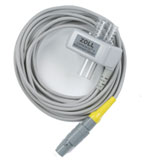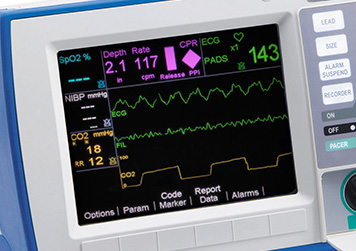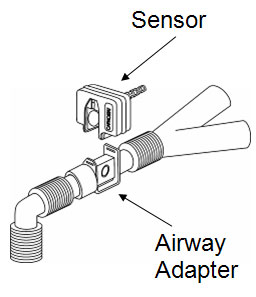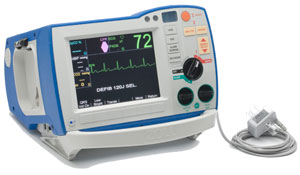End-Tidal CO2

What is Capnography?
Capnography is the measurement and numerical display of End-Tidal Carbon Dioxide (also known as EtCO2).
EtCO2 is the maximum expired carbon dioxide concentration during a respiratory cycle.
The graphical representation of the concentration or partial pressure of expired carbon dioxide during a respiratory cycle is shown in a waveform format and is known as a capnogram.
A normal capnogram as displayed on the ZOLL R Series Defibrillator.
This provides information not only regarding pulmonary function, but also indirect cardiac function, ventilator function and perfusion.
Download a pocket guide to common abnormal capnograms.
Why use Capnography?
The American Heart Association (AHA) 2015 Guidelines gives a Class 1, LOE A recommendation for the use of continuous waveform capnography as the most reliable method of confirming and monitoring correct placement of an endotracheal tube.
AHA also states that a sustained increase in PETCO2 during CPR is an indicator of ROSC. Due to this fact, it is also recommended to use capnography in intubated patients to monitor CPR quality, optimize chest compressions, and detect ROSC during chest compressions or when the rhythm check reveals an organized rhythm (Class IIb, LOE C).
What is Mainstream Capnography?
Mainstream is most commonly used for mechanically ventilated patients and those that are intubated that require intensive monitoring. Mainstream devices are also used on non-intubated patients using a mouthpiece or by a mask.
With mainstream capnography, the airway adapter is placed directly in the breathing circuit in between the ventilator “Y” and the elbow adapter, as shown in the diagram.
A mainstream sensor is then attached to the adapter. As the patient exhales, the CO2 rich gas passes through the airway adapter where it is measured. Because the mainstream sensor is not in direct contact with the patient, it cannot be contaminated by moisture or secretions. If the mainstream airway adapter becomes contaminated with secretions, water or by an aerosolized medication, it can be removed and replaced. The actual mainstream sensor does not need to be replaced.
What Mainstream EtCO2 On the R Series can do for you
- Rapid warm-up time allows you to start monitoring faster
- No clogging due to secretions
- No water traps or tubing needed
- Easy-to-use airway adapters provide hassle-free uninterrupted monitoring.
- Displays a printable capnogram on the defibrillator screen for easy identification of abnormal waveforms.



